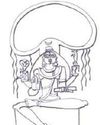
Judaism, Christianity, and Islam are presented in the synagogue, church, and mosque as God's instructions to humanity on how to live life. In recent times, a new group of Hindu missionaries, who first appeared during India's national movement, is following the same path of instruction-based 'Satsangs; but it is hardly institutional, for Hinduism is not commandment-based. It is story-based; and stories, unlike instructions, appeal more to emotions than actions.
Animals do not tell each other stories. Humans do - for entertainment, for propaganda, for memory and history transmission, and, most importantly, for meaning. Stories transmitted over generations serve as the glue of a community.
This is why Christianity is established by two stories that are repeated twice a year: in springtime, the story of the crucifixion of Jesus and his resurrection; and in winter, the story of his birth. In Shia Islam, the story that glues the people together is the martyrdom of the Prophet's family. The ritual of Ramazan is a reminder of a story of when the angel of God communicated God's will to Muhammad, the final prophet for Muslims.
Bu hikaye Yoga and Total Health dergisinin July 2024 sayısından alınmıştır.
Start your 7-day Magzter GOLD free trial to access thousands of curated premium stories, and 9,000+ magazines and newspapers.
Already a subscriber ? Giriş Yap
Bu hikaye Yoga and Total Health dergisinin July 2024 sayısından alınmıştır.
Start your 7-day Magzter GOLD free trial to access thousands of curated premium stories, and 9,000+ magazines and newspapers.
Already a subscriber? Giriş Yap

Moringa Flowers
Edible flowers? Yes! Ayurveda mentions many edible flowers. One of them is the Moringa flower.

You Gain Some, You Lose Some
Recently, we the Chennaites, got the opportunity to get blessings from His Sharada Peetam.

A Healthy Body
An incident from Swami Vivekananda's Life

A Man Himself is Responsible for His Deeds
Renouncing doer-ship

The Unstructured Drama of Life
Go for the silent roles

Positive Thinking and Meditation
A life-raft for seniors

Soul Connects
The Yoga Institute’s Reach Out Camp

The Wood Wide Web
As a kid, Suzanne Simard grew up in the rainforests of British Columbia and she normally spent her summers visiting forests around and exploring them along with her family, which included a curious dog named Jiggs.

More About Dharma and Duty
Considering One's Own Background (Part 2)

Devaluing Your Value
The lure of more